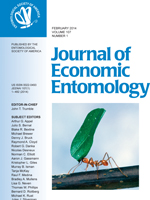Phlyctinus callosus (Boheman) (Coleoptera: Curculionidae) is a pest of major phytosanitary concern for some of South Africa's biggest export markets such as the United States and Europe because this pest does not occur there. At present, fumigation with methyl bromide is the only postharvest disinfestation treatment against this pest; therefore, sustainable alternatives are needed. One such alternative is irradiation treatment of whole pallets of packed fruit to sterilize insects that may be present within the cartons. Wild adult P. callosus weevils were treated with 5, 10, 20, 40, and 80 Gy of γ-irradiation and then cross mated to breed with either treated or nontreated adults of the opposite sex. Fecundity and fertility were monitored and recorded. Trials were conducted during the 2009–2010 and 2010–2011 fruit harvesting seasons. The results from both seasons indicated that irradiation did not affect fecundity but fertility was significantly affected, decreasing as irradiation doses increased. Egg hatch was zero for mating crosses that involved females weevils treated with a dose of 80 Gy γ-irradiation. Probit analysis indicated that in the first season, the estimated LD95 for crosses involving treated males and treated females was 30 Gy, while in the second season it was 49.5 Gy. Respective estimated LD99s were 47.9 and 169.4 Gy. Ultimately, a dose lower than the current generic dose of 400 Gy, approved for irradiation disinfestation treatments, would control P. callosus should they occur in packed export fruit.
How to translate text using browser tools
1 February 2014
The Potential of Irradiation as a Postharvest Disinfestation Treatment Against Phlyctinus callosus (Coleoptera: Curculionidae)
A. J. Duvenhage,
S. A. Johnson
ACCESS THE FULL ARTICLE
It is not available for individual sale.
This article is only available to subscribers.
It is not available for individual sale.
It is not available for individual sale.
fecundity
fertility
irradiation
Phlyctinus callosus
phytosanitary





